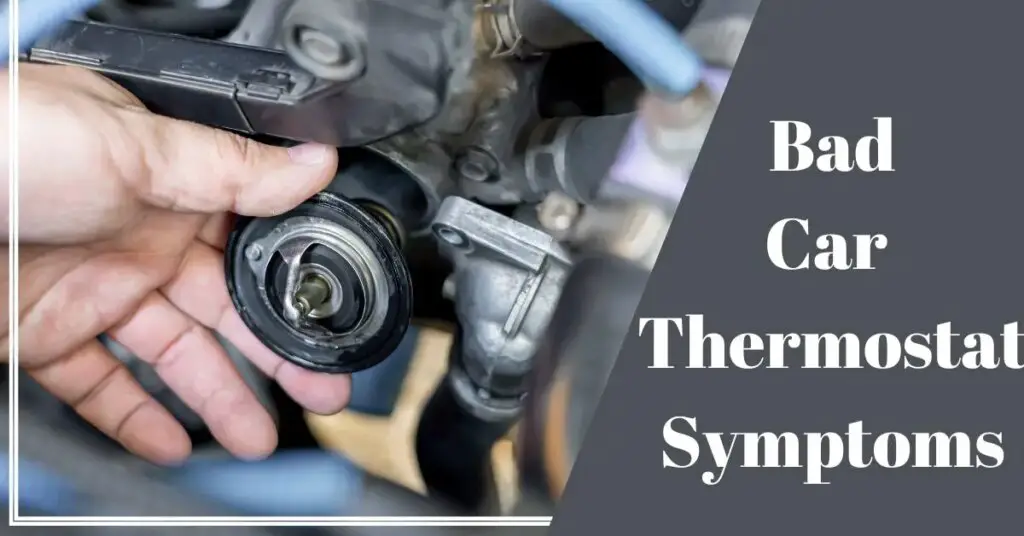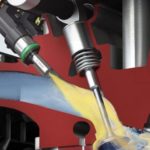Looking for common bad thermostat in car symptoms?
Wondered if a faulty thermostat can turn your smooth ride into a steamy situation? Get ready for a temperature-taming adventure!
In this guide, we’re diving into the world of car thermostats, from their sneaky symptoms to hands-on fixes.
Discover why your engine might throw a heatwave, why that temperature gauge has a mind of its own, and how a tiny thermostat can play traffic cop for your car’s performance.
Buckle up – it’s time to decode the mystery of the thermostat and keep your cool on the road!
Table of Contents
What is a Car Thermostats?
A car thermostat is a crucial component of a vehicle’s cooling system, responsible for regulating the engine’s operating temperature. The engine generates a significant amount of heat during operation, and it’s essential to maintain a consistent temperature range for optimal performance and longevity.
The car thermostat plays a pivotal role in achieving this by controlling the flow of coolant through the engine.
Car Thermostat in Engine Temperature Regulation:
The primary function of a car thermostat is to manage the flow of coolant between the engine and the radiator to maintain a stable operating temperature.
Coolant Circulation: When the engine is cold, the thermostat remains closed, preventing the flow of coolant to the radiator. Instead, the coolant circulates within the engine to help it reach its optimal operating temperature more quickly.
Opening Phase: As the engine warms up, the thermostat gradually opens. This allows coolant to flow from the engine to the radiator. This circulation facilitates heat exchange, dissipating excess heat and preventing the engine from overheating.
Regulation: The thermostat continues to adjust its position based on the engine’s temperature. If the engine gets too hot, the thermostat opens wider to increase coolant flow, cooling the engine. Conversely, if the engine temperature drops, the thermostat closes partially to restrict coolant flow and help the engine maintain its ideal operating temperature.
Importance of a Well-Functioning Thermostat
A properly functioning car thermostat is critical for several reasons:
Maintaining Optimal Engine Temperature
Engines operate most efficiently within a specific temperature range. If the engine runs too hot, it can lead to accelerated wear, reduced performance, and potential damage to components. Conversely, operating at too low a temperature can lead to poor fuel combustion and increased emissions.
Fuel Efficiency and Emission Control
A well-regulated engine temperature ensures that fuel combustion occurs optimally, leading to improved fuel efficiency. It also aids in reducing harmful emissions, as complete combustion at the correct temperature results in fewer pollutants being released into the environment.
Preventing Overheating
A malfunctioning thermostat that remains closed can cause the engine to overheat, leading to potential engine damage, breakdowns, and costly repairs.
Longevity of Engine Components
Consistent temperature regulation helps extend the lifespan of engine components, such as gaskets, seals, and lubricants, by preventing extreme temperature variations that can cause these parts to degrade faster.
A car thermostat is a vital component that plays a pivotal role in maintaining the engine’s optimal temperature range. This, in turn, leads to improved fuel efficiency, reduced emissions, and overall better engine performance and longevity.
Common Causes of Thermostat Failure
Wear and Tear Over Time
Like any mechanical component, a thermostat can wear out over time due to constant use and exposure to high temperatures. The thermostat’s internal components may become less responsive or less capable of maintaining accurate temperature regulation.
Corrosion and Deposits
The cooling system contains coolant that has additives to prevent corrosion and deposits from forming. However, over time, these additives can break down, leading to the buildup of rust, scale, and other deposits within the thermostat. This buildup can hinder the thermostat’s movement and cause it to malfunction.
Stuck Thermostat Valve
The thermostat valve can become stuck in either the open or closed position due to mechanical issues or deposits. If it’s stuck closed, coolant flow to the radiator is restricted, leading to overheating. If it’s stuck open, the engine may not reach its optimal operating temperature, resulting in poor fuel efficiency and emissions.
The Telltale Signs of a Bad Thermostat
Engine Overheating
One of the most noticeable signs of a failing thermostat is engine overheating. If the thermostat is stuck closed, coolant won’t circulate through the radiator, causing the engine to rapidly overheat.
Temperature Gauge Fluctuations
A malfunctioning thermostat can cause the temperature gauge on your dashboard to fluctuate abnormally. You might see the temperature rise and fall rapidly instead of maintaining a steady level.
Cold or Hot Air from the Heater
If the thermostat is stuck open, the engine may not reach its proper operating temperature. As a result, the heater may blow lukewarm or even cold air instead of the expected warm air.
Slow Warm-Up of the Engine
A failing thermostat might cause the engine to take longer than usual to warm up. This delay can impact fuel efficiency and emissions, as the engine doesn’t reach its optimal operating temperature quickly.
Low Coolant Levels
A malfunctioning thermostat can lead to coolant not flowing properly, which can cause fluctuations in coolant levels. If you notice a sudden drop in coolant levels without any visible leaks, it could be a sign of a thermostat issue.
Common Bad Thermostat in Car Symptoms
Engine Overheating and Steam
- Explanation of Engine Overheating: Engine overheating occurs when the engine’s operating temperature rises beyond the safe range. This can happen due to a malfunctioning thermostat that is stuck closed, preventing coolant circulation. Without proper cooling, the engine generates excessive heat, which can lead to damage or even engine failure.
- Steam Rising from the Engine Bay: If you notice steam rising from the engine bay, it’s often a sign of coolant boiling due to excessive heat. This can be caused by a faulty thermostat that doesn’t allow coolant to flow to the radiator for proper cooling. Steam is a visible indicator of a severe overheating issue that requires immediate attention to prevent further damage.
Temperature Gauge Fluctuations
- Erratic Movement of the Temperature Gauge: A malfunctioning thermostat can cause irregular fluctuations in the temperature gauge on your dashboard. The gauge might show rapid changes in temperature, rising and falling unexpectedly, indicating that the thermostat is not maintaining a steady coolant flow and engine temperature.
- Connection to Thermostat Irregularities: The thermostat regulates coolant flow, affecting the engine’s operating temperature. When the thermostat is faulty, it can lead to unstable temperature readings on the gauge, signaling that the engine is not being properly cooled or heated as needed.
Inconsistent Heater Performance
- Cold Air When Expecting Hot Air: The car’s heater relies on the engine’s coolant to produce warm air. A malfunctioning thermostat, especially one stuck open, can prevent the engine from reaching its optimal operating temperature. As a result, the heater may blow cold air instead of the expected warm air, indicating that the engine isn’t generating enough heat.
- Causes Related to Thermostat Malfunction: If the thermostat is stuck open or closed, it affects the coolant flow through the engine and radiator. This can disrupt the normal heating process, leading to inconsistent heater performance and discomfort for the vehicle occupants.
Prolonged Engine Warm-up
- Increased Time Taken for the Engine to Reach Operating Temperature: A malfunctioning thermostat, particularly one stuck open, can cause the engine to take longer than usual to reach its optimal operating temperature. This extended warm-up period affects fuel combustion efficiency and may result in reduced fuel economy.
- Impact on Fuel Efficiency: Engines are designed to operate efficiently within a specific temperature range. A faulty thermostat that causes prolonged engine warm-up can lead to incomplete combustion and decreased fuel efficiency. The engine may also emit higher levels of pollutants as a result.
Low Coolant Levels
- Importance of Coolant for Engine Cooling: Coolant, also known as antifreeze, is a vital fluid that helps regulate the engine’s temperature. It absorbs heat from the engine and transfers it to the radiator for dissipation. A malfunctioning thermostat can disrupt the flow of coolant, leading to improper cooling and potential overheating.
- Thermostat-Related Coolant Loss: A stuck closed thermostat can cause coolant to remain trapped in the engine, leading to high temperatures and potential boiling. This can result in coolant loss due to evaporation, leading to low coolant levels in the radiator and reservoir.
A faulty thermostat can manifest in various symptoms, including engine overheating, erratic temperature gauge readings, inconsistent heater performance, prolonged engine warm-up, and low coolant levels. Recognizing these signs and addressing them promptly is essential to prevent further damage to your vehicle’s engine and cooling system.
Diagnosing and Resolving Thermostat Issues
When dealing with thermostat issues, it’s important to accurately diagnose the problem and take appropriate steps to resolve it.
Visual Inspection and Testing
Checking for Visible Signs of Damage: Inspect the thermostat and associated components for any visible signs of damage, corrosion, or leakage. Look for cracks, rust, or other indications of wear.
Using a Diagnostic Scanner for Temperature Readings: A diagnostic scanner can provide real-time temperature readings from various engine components, including the thermostat. This can help you determine if the thermostat is functioning correctly or if there are irregularities in temperature regulation.
Flushing the Cooling System
Removing Deposits and Debris: Over time, deposits and debris can accumulate in the cooling system, including the thermostat. Flushing the cooling system involves draining the old coolant, flushing the system with a mixture of water and a cooling system cleaner, and then refilling it with fresh coolant. This process helps remove buildup that may affect the thermostat’s performance.
Enhancing Thermostat Functionality: Flushing the cooling system can help improve coolant flow and overall system efficiency, which can indirectly contribute to proper thermostat function.
Replacing the Thermostat
Step-by-Step Guide to Replacing a Car Thermostat:
- Gather Necessary Tools and Materials: You’ll need a new thermostat, a gasket or seal (if applicable), a socket set, a drain pan, a funnel, coolant, and basic hand tools.
- Drain Coolant: Ensure the engine is cool, then use a drain pan to catch the coolant as you remove the radiator drain plug or lower radiator hose.
- Locate the Thermostat Housing: Follow the upper radiator hose to locate the thermostat housing. It’s usually connected to the engine.
- Remove the Thermostat Housing: Disconnect any hoses or components connected to the housing, then use a socket set to remove the bolts securing the housing.
- Replace the Thermostat: Remove the old thermostat, noting its orientation, and replace it with the new one. Make sure the new thermostat is correctly aligned.
- Replace Gasket or Seal: If your thermostat housing uses a gasket or seal, replace it with a new one to ensure a proper seal.
- Reassemble: Put everything back together in the reverse order. Tighten bolts to the specified torque.
- Refill Coolant: Refill the cooling system with the appropriate coolant and water mixture according to your vehicle’s specifications.
Choosing the Right Thermostat for Your Vehicle
- Consult Your Vehicle Manual: Check your vehicle’s manual for the correct thermostat specifications, including size, opening temperature, and compatibility.
- OEM or Aftermarket: You can choose between Original Equipment Manufacturer (OEM) thermostats or aftermarket options. OEM thermostats are designed to match your vehicle’s original specifications, while aftermarket ones may offer specific features or performance enhancements.
- Quality and Brand: Opt for reputable brands known for producing high-quality automotive components.
Find your replacement car thermostats on Amazon HERE
Frequently Asked Questions
1. Can a bad thermostat cause my engine to overheat completely?
Yes, a bad thermostat can lead to engine overheating. If the thermostat is stuck closed, coolant flow to the radiator is restricted, preventing proper cooling and causing the engine to overheat.
2. Why does my temperature gauge sometimes show normal and other times overheating?
A fluctuating temperature gauge can be indicative of a malfunctioning thermostat. If the thermostat is intermittently sticking open or closed, it can cause temperature variations, leading to gauge readings that go from normal to overheating.
3. How does a faulty thermostat impact fuel efficiency?
A faulty thermostat, especially if stuck open, can lead to prolonged engine warm-up. This delays the engine’s optimal operating temperature, causing inefficient fuel combustion and decreased fuel efficiency.
4. Can a stuck-open thermostat lead to slow engine warm-up?
No, a stuck-open thermostat typically leads to quicker engine warm-up because coolant circulates continuously, warming up the engine faster. A stuck-closed thermostat, on the other hand, can cause slow engine warm-up.
5. Is driving with a bad thermostat damaging to my engine?
Driving with a bad thermostat can potentially cause engine damage due to overheating. It’s advisable to address thermostat issues promptly to prevent overheating and potential engine damage.
6. What’s the role of coolant in thermostat-related issues?
Coolant, also known as antifreeze, helps regulate engine temperature by absorbing heat and transferring it to the radiator. A malfunctioning thermostat can disrupt the flow of coolant, leading to temperature imbalances and overheating.
7. Are there any temporary solutions for a bad thermostat?
Temporary solutions may include removing the thermostat to allow continuous coolant flow. However, this is not recommended as it can affect engine performance and fuel efficiency. It’s best to replace a faulty thermostat for a proper fix.
8. Can a malfunctioning thermostat affect my car’s emissions?
Yes, a malfunctioning thermostat can affect emissions. Operating the engine at the incorrect temperature can lead to incomplete fuel combustion and increased emissions of pollutants.
9. How often should I replace my car’s thermostat?
There’s no set interval for thermostat replacement. It’s best to follow your vehicle manufacturer’s recommended maintenance schedule and replace the thermostat if you notice symptoms of malfunction.
10. What other components should I inspect when diagnosing thermostat problems?
When diagnosing thermostat issues, it’s wise to inspect the radiator, hoses, water pump, coolant levels, and any related sensors. These components are interconnected in the cooling system and can contribute to temperature regulation.
In conclusion, recognizing the symptoms of a bad thermostat is crucial for maintaining your car’s performance and preventing potential engine damage. Engine overheating, temperature gauge fluctuations, inconsistent heater performance, prolonged engine warm-up, and low coolant levels are all indicators of a malfunctioning thermostat.
Timely diagnosis and appropriate actions such as visual inspection, testing, flushing the cooling system, and thermostat replacement can help you address these issues effectively. By paying attention to these signs and taking proactive measures, you can ensure that your car’s thermostat operates smoothly, contributing to optimal engine performance and longevity.
Find your replacement car thermostats on Amazon HERE
Hi there! I’m Naomi O’Colman. I’ve got years of experience working at an auto repair shop here in Texas under my belt. On top of that, ever since I was a kid I’ve been passionate about the auto industry. Since I’ve joined the team at automotivegearz.com I’ve been enthusiastically sharing my passion and insights with my readers. I’m dedicated to delivering high quality content and helping you stay up to date with the latest automotive trends and products out there!







